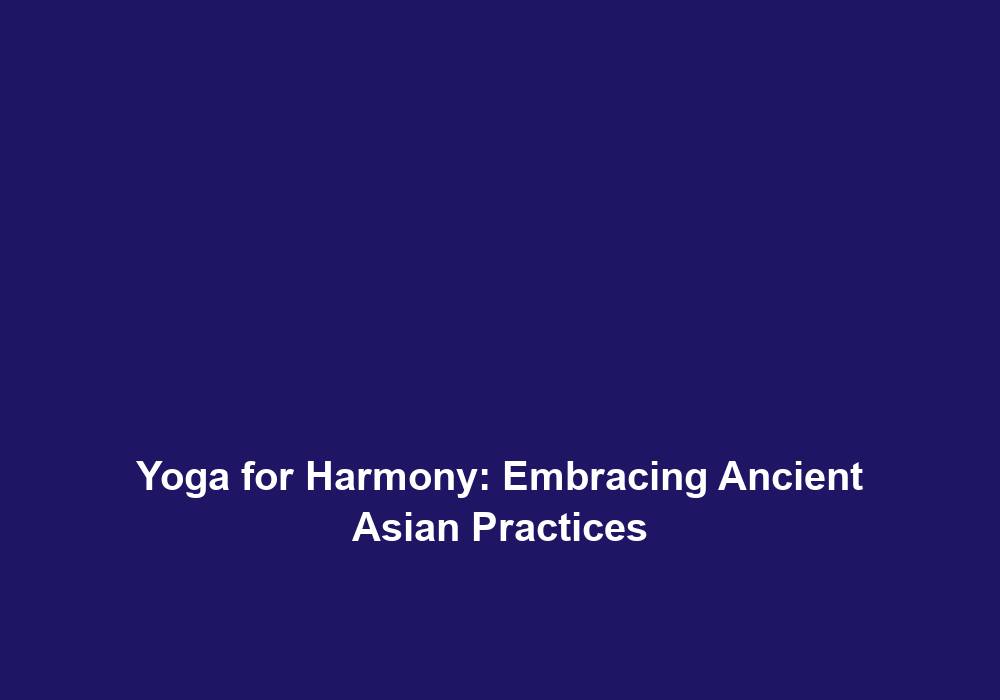Yoga for Harmony: Embracing Ancient Asian Practices
Yoga is a spiritual and physical practice that originated in ancient Asia and has been passed down through generations. It is more than just a form of exercise; it is a holistic approach to achieving harmony in mind, body, and spirit. Through various techniques such as postures, breathing exercises, and meditation, yoga offers numerous benefits for overall well-being. In this article, we will explore the ancient Asian practices of yoga and delve into the transformative power it holds.
Understanding the Essence of Yoga
Yoga is deeply rooted in ancient Asian cultures, particularly in India, where it originated thousands of years ago. The word yoga comes from the Sanskrit word yuj, which means to unite or join. This union refers to the integration of mind, body, and spirit, aiming to achieve a state of inner harmony and balance.
Physical and Mental Benefits
-
Improved Flexibility: Yoga involves a series of postures, known as asanas, which help to increase flexibility and strengthen muscles. Regular practice can enhance joint mobility and reduce the risk of injuries. By stretching and lengthening the muscles, yoga promotes better range of motion and overall flexibility.
-
Enhanced Strength: The various physical poses in yoga require strength and stability, which can be developed over time. Strong muscles contribute to better posture and overall body strength. Through consistent practice, yoga builds lean muscle mass and improves muscular endurance.
-
Stress Relief: Yoga incorporates breathing exercises and meditation, which promote relaxation and help manage stress. These practices can calm the mind, reduce anxiety, and improve overall mental well-being. By focusing on the breath and being present in the moment, yoga cultivates a sense of tranquility and inner peace.
-
Increased Focus and Concentration: The combination of physical movement and mindful awareness in yoga can improve concentration and enhance cognitive abilities. Regular yoga practice has been shown to boost brain function and memory. By quieting the mind and directing attention to the present moment, yoga enhances mental clarity and focus.
-
Balanced Energy Flow: Yoga aligns the body’s energy centers, known as chakras, promoting the smooth flow of energy throughout the body. This balance can lead to increased vitality and overall well-being. By activating and balancing the chakras, yoga restores harmony within the body and supports optimal energy flow.
Exploring Different Yoga Styles
Yoga encompasses various styles and approaches, each with its own unique focus and benefits. Some popular yoga styles include:
1. Hatha Yoga
Hatha yoga is one of the most commonly practiced forms of yoga. It emphasizes physical postures and breath control, making it suitable for beginners. Hatha yoga helps build strength, flexibility, and balance while promoting relaxation and stress reduction. It is a gentle and accessible style that can be adapted to individual needs and abilities.
2. Vinyasa Yoga
Vinyasa yoga is a more dynamic style that focuses on fluid movements and breath synchronization. It involves smoothly transitioning from one pose to another, creating a flowing sequence. Vinyasa yoga builds strength, endurance, and improves cardiovascular health. It offers a cardiovascular workout while promoting mindfulness and breath awareness.
3. Ashtanga Yoga
Ashtanga yoga follows a set sequence of poses, performed in a specific order. It is a physically demanding practice that builds strength, flexibility, and stamina. Ashtanga yoga practitioners often experience improved focus and discipline. This vigorous and structured style emphasizes synchronization of breath and movement for a challenging and transformative experience.
4. Yin Yoga
Yin yoga is a slow-paced style that targets deep connective tissues in the body. It involves holding poses for an extended period, allowing the body to relax and release tension. Yin yoga enhances flexibility, promotes mindfulness, and stimulates the flow of energy. By surrendering to gravity and practicing stillness, Yin yoga provides a meditative and introspective practice.
Incorporating Yoga into Daily Life
To fully embrace the benefits of yoga, it is essential to integrate it into your daily routine. Here are some practical tips to incorporate yoga into your life:
-
Create a Sacred Space: Designate a quiet and peaceful area in your home where you can practice yoga. Fill it with items that inspire tranquility, such as candles, incense, or soft lighting. Creating a dedicated space for your practice enhances the sense of sacredness and helps set the right atmosphere.
-
Set a Regular Practice Time: Establish a consistent yoga practice by allocating a specific time each day for your sessions. Whether it’s in the morning to energize your day or in the evening to unwind, consistency is key. By committing to a regular practice time, you create a routine that supports your yoga journey.
-
Start with Simple Poses: If you are new to yoga, begin with basic poses and gradually progress to more advanced ones. Starting slowly allows you to build strength and flexibility while preventing injuries. It is important to listen to your body and honor its limitations, gradually expanding your practice as you become more comfortable and confident.
-
Find a Qualified Instructor: Attending yoga classes led by a qualified instructor can greatly enhance your practice. They can guide you in proper alignment, offer variations for different abilities, and help you deepen your understanding of yoga philosophy. A skilled instructor can provide personalized guidance and support to help you progress in your practice.
-
Practice Mindful Breathing: Breathing exercises, or pranayama, are an integral part of yoga. Incorporate conscious breathing techniques into your practice to enhance relaxation, focus, and self-awareness. By consciously directing the breath, you can regulate the body’s energy and create a sense of calm and balance.
The Holistic Benefits of Yoga
Yoga goes beyond physical exercise and offers holistic benefits that extend to all aspects of life. By regularly practicing yoga, you can experience:
-
Improved Emotional Well-being: Yoga cultivates self-awareness and mindfulness, allowing you to better understand and manage your emotions. It can help reduce feelings of anxiety, depression, and stress, promoting emotional balance. Through the practice of yoga, you develop emotional resilience and a greater sense of inner peace.
-
Enhanced Spiritual Connection: Yoga provides a pathway to connect with your inner self and the world around you. Through meditation and reflection, you can deepen your spiritual journey and experience a sense of unity and interconnectedness. Yoga offers a profound opportunity for self-discovery and spiritual growth.
-
Promotion of Self-Care: Incorporating yoga into your routine encourages self-care and self-love. It reminds you to prioritize your well-being, both physically and mentally, fostering a healthier and more balanced lifestyle. By dedicating time to your yoga practice, you honor and nurture yourself, creating a foundation of self-care.
Embrace the Ancient Wisdom of Yoga
Yoga has stood the test of time and continues to be a valuable practice for individuals seeking harmony and balance in their lives. By embracing the ancient Asian practices of yoga, you can embark on a transformative journey that nurtures your mind, body, and spirit. Start your yoga journey today and experience the profound benefits it offers. Namaste.
Note: This article has been written in markdown format for easy readability and formatting purposes.







